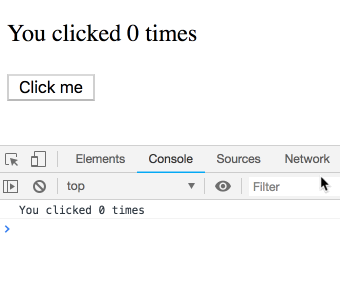React Hooks and Component Lifecycle Equivalent
componentDidMount
Pass an empty array as the second argument to useEffect() to run only the callback on mount only.
function ComponentDidMount() {
const [count, setCount] = React.useState(0);
React.useEffect(() => {
console.log('componentDidMount');
}, []);
return (
<div>
<p>componentDidMount: {count} times</p>
<button
onClick={() => {
setCount(count + 1);
}}
>
Click Me
</button>
</div>
);
}
ReactDOM.render(
<div>
<ComponentDidMount />
</div>,
document.querySelector("#app")
);<script src="https://unpkg.com/[email protected]/umd/react.development.js"></script>
<script src="https://unpkg.com/[email protected]/umd/react-dom.development.js"></script>
<div id="app"></div>componentDidUpdate
componentDidUpdate() is invoked immediately after updating occurs. This method is not called for the initial render. useEffect runs on every render including the first. So if you want to have a strict equivalent as componentDidUpdate, you have to use useRef to determine if the component has been mounted once. If you want to be even stricter, use useLayoutEffect(), but it fires synchronously. In most cases, useEffect() should be sufficient.
This answer is inspired by Tholle, all credit goes to him.
function ComponentDidUpdate() {
const [count, setCount] = React.useState(0);
const isFirstUpdate = React.useRef(true);
React.useEffect(() => {
if (isFirstUpdate.current) {
isFirstUpdate.current = false;
return;
}
console.log('componentDidUpdate');
});
return (
<div>
<p>componentDidUpdate: {count} times</p>
<button
onClick={() => {
setCount(count + 1);
}}
>
Click Me
</button>
</div>
);
}
ReactDOM.render(
<ComponentDidUpdate />,
document.getElementById("app")
);<script src="https://unpkg.com/[email protected]/umd/react.development.js"></script>
<script src="https://unpkg.com/[email protected]/umd/react-dom.development.js"></script>
<div id="app"></div>componentWillUnmount
Return a callback in useEffect's callback argument and it will be called before unmounting.
function ComponentWillUnmount() {
function ComponentWillUnmountInner(props) {
React.useEffect(() => {
return () => {
console.log('componentWillUnmount');
};
}, []);
return (
<div>
<p>componentWillUnmount</p>
</div>
);
}
const [count, setCount] = React.useState(0);
return (
<div>
{count % 2 === 0 ? (
<ComponentWillUnmountInner count={count} />
) : (
<p>No component</p>
)}
<button
onClick={() => {
setCount(count + 1);
}}
>
Click Me
</button>
</div>
);
}
ReactDOM.render(
<div>
<ComponentWillUnmount />
</div>,
document.querySelector("#app")
);<script src="https://unpkg.com/[email protected]/umd/react.development.js"></script>
<script src="https://unpkg.com/[email protected]/umd/react-dom.development.js"></script>
<div id="app"></div>From React docs:
If you’re familiar with React class lifecycle methods, you can think of useEffect Hook as componentDidMount, componentDidUpdate, and componentWillUnmount combined.
By that saying they mean:
componentDidMount is sort of useEffect(callback, [])
componentDidUpdate is sort of useEffect(callback, [dep1, dep2, ...]) - the array of deps tell React: "if one of the deps is change, run the callback after rendering".
componentDidMount + componentDidUpdate is sort of useEffect(callback)
componentWillUnmount is sort of the returned function from the callback:
useEffect(() => {
/* some code */
return () => {
/* some code to run when rerender or unmount */
}
)
With the help of Dan Abramov's phrasing from his blog, and some additions of my own:
While you can use those hooks, it’s not an exact equivalent. Unlike componentDidMount and componentDidUpdate, it will capture props and state. So even inside the callbacks, you’ll see the props and state of the specific render (which means in componentDidMount the initial props and state). If you want to see “latest” something, you can write it to a ref. But there’s usually a simpler way to structure the code so that you don’t have to.
The returned function which supposes to be alternative to componentWillUnmount also is not an exact equivalent, since the function will run every time the component will re-render and when the component will unmount.
Keep in mind that the mental model for effects is different from component lifecycles, and trying to find their exact equivalents may confuse you more than help. To get productive, you need to “think in effects”, and their mental model is closer to implementing synchronization than to responding to lifecycle events.
Example from Dan's blog:
function Counter() {
const [count, setCount] = useState(0);
useEffect(() => {
setTimeout(() => {
console.log(`You clicked ${count} times`);
}, 3000);
});
return (
<div>
<p>You clicked {count} times</p>
<button onClick={() => setCount(count + 1)}>
Click me
</button>
</div>
);
}

If we use the class implementation:
componentDidUpdate() {
setTimeout(() => {
console.log(`You clicked ${this.state.count} times`);
}, 3000);
}

this.state.count always points at the latest count rather than the one belonging to a particular render.
For Simple Explanation, I would like to show a visual reference

As we can see simply in the above picture that for -
componentDidMount :
useEffect(() => {
console.log('componentWillMount');
}, []);
componentDidUpdate :
useEffect(() => {
console.log('componentWillUpdate- runs on every update');
});
useEffect(() => {
console.log('componentWillUpdate - runs if dependency value changes ');
},[Dependencies]);
componentwillUnmount :
useEffect(() => {
return () => {
console.log('componentWillUnmount');
};
}, []);